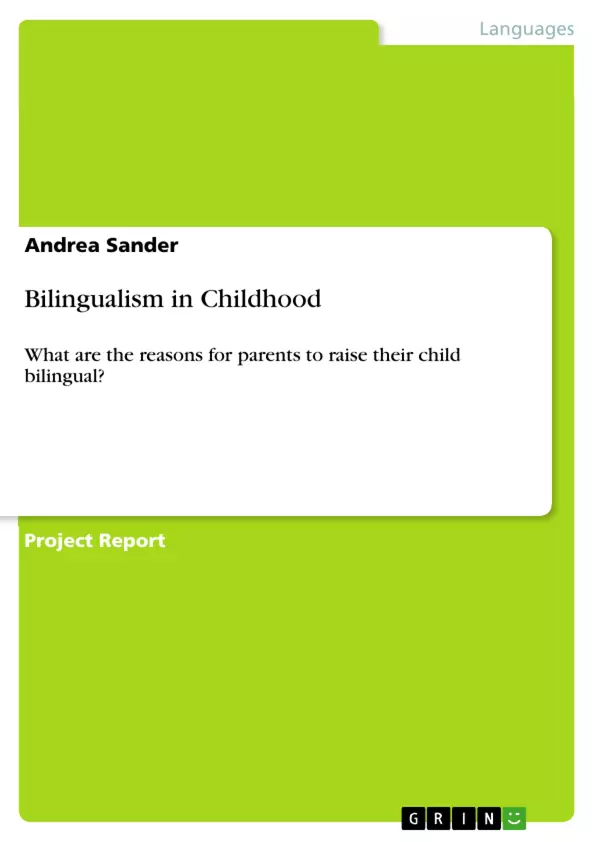A lot of people in the world are bilingual. People in Africa and Asia often speak their
community language and additionally an official language like English or French. It is
not a big surprise when calling in mind that according to Prof. Dr. Martin Haspelmath
of the Max-Planck-Institut für evolutionäre Anthropologie, Leipzig there are about
6500-7000 languages in the world and according to www.welt-in-zahlen.de 193
countries. That makes an average of 35 languages per country.
Despite the fact that bilingualism is widespread, there are a lot of negative
opinions in the mind of people. People say for example “Your kid is going to get all
these languages mixed up.”, “when will she (or he) use that (language)” (both cf.
Bosemark, 2006b, my italics) or that bilingual children are overstrained and that they
start later to talk than their monolingual peers (cf. Leist-Villis, 2008).
Within this research-paper I will deal with bilingualism in childhood. More
precisely I will answer the research question “What are the reasons for parents to
raise their child bilingually”. First I will define the term bilingualism. For that I quote a
few definitions of bilingualism from experts and afterwards I will define the one I will
work with. Afterwards I will introduce some successful methods applied by parents
and I will point out the advantages and disadvantages of the methods I found in
literature. I will continue explaining the research I have done on the topic followed by
the analysis of my data. Concluding I will answer the research question and give a
prospective view on possible future research.
Bilingualism is a huge topic and to look on it more deeply I decided to consider
families who raised their children English-German or German-English. To get in
contact with families bringing up their children in that way, I wrote articles in internet
communities and designed a questionnaire that I sent to several families raising their
child/ren bilingually who answered my requests. In addition to the internet and my
questionnaire I considered books that deal with the topic.
Table of Contents
- Introduction
- Bilingualism
- Definition of Bilingualism
- Types of Bilingualism
- Simultaneous Bilingualism
- Successive Bilingualism
- Raising a Bilingual Child
- Methods
- One Person One Language (OPOL)
- Minority Language at Home (ML@H)
- Artificial Bilingualism
- Advantages and Disadvantages
- Mixing and code-switching
- Language delay
- Interference
- Semilingualism
- Explanation of Research
- Data collection
- The questionnaire
- Analysis
- Analysis of questionnaires
- Reasons for parents
Objectives and Key Themes
This research paper investigates the reasons parents choose to raise their children bilingually. The study focuses on English-German or German-English bilingual families. The research methodology involved online surveys and questionnaires sent to families raising bilingual children.
- Definition and types of bilingualism (simultaneous vs. successive).
- Methods employed by parents in raising bilingual children (e.g., OPOL, ML@H).
- Advantages and disadvantages of bilingual upbringing.
- Analysis of parental motivations for bilingual childrearing.
- Research methodology and data collection techniques.
Chapter Summaries
The introduction establishes the prevalence of bilingualism globally and highlights common misconceptions surrounding it. Chapter 1 defines bilingualism, drawing on various expert opinions, and differentiates between simultaneous and successive bilingualism. Chapter 2 explores different methods parents use to raise bilingual children, including the One Person One Language (OPOL) method and the Minority Language at Home (ML@H) approach, and discusses the associated advantages and disadvantages. Chapter 3 outlines the research methodology employed in the study, focusing on data collection methods.
Keywords
Bilingualism, childhood bilingualism, simultaneous bilingualism, successive bilingualism, parental motivations, language acquisition, research methodology, questionnaires, OPOL, ML@H.
- Quote paper
- Andrea Sander (Author), 2009, Bilingualism in Childhood, Munich, GRIN Verlag, https://www.hausarbeiten.de/document/124518


